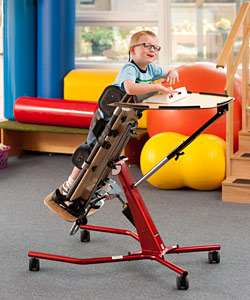Is there a role for assistive technology in activity-based intervention for children?

Toby: Absolutely. I think assistive technology is playing a much bigger part in much younger children’s lives. Traditionally, assistive technology equipment has been introduced to children when team members have determined that the child is not going to learn certain things. "Now that the child is 8 or 9, and is not going to learn to walk, we may start thinking about a wheelchair or another type of mobility device." More recently, however, people are beginning to think "This little guy is going to have a hard time moving around. Let’s give this 18-month-old a mobility device to get him moving around the environment." Then they can explore their environment actively, while we are working on independent mobility, rather than being passively carried from place to place. It’s about giving them that ability to move around their environment on their own.
We’ve known for many years that active exploration of their environment is very important for cognitive development in small children. Research is showing that, when given a simple mobility device, young babies develop better cognitive skills than those who are not able to explore their environment on their own and are passively moved around or have their environment brought to them. So I think that independent mobility using assistive technology is extremely important.
Providing a young child with assistive technology is not saying that you’re not going to work on a skill. Think about this in terms of communication devices. We want to provide ways for kids to communicate on their own as early as possible, and not wait until we’ve decided they’re not going to learn to speak. There is no evidence to indicate that providing assistive technology equipment for communication or for mobility prevents the acquisition of either speech communication or independent mobility for a child who develops those skills. In fact, the assistive technology may promote communication or mobility, because it reinforces it. If a young child who cannot speak has a communication system, somebody is going to communicate with them and reinforce their reciprocal social interaction. This reinforces their desire to communicate, because now they have a social network. If the only time that they are able to communicate with somebody is when they go to the speech therapist, they may not be as motivated to make that communicative attempt.
More and more we all recognize the importance of these evidence-based interventions. Newer therapists are coming out of their training with more realization of and appreciation for these concepts of motor learning and team collaboration for service delivery. Unfortunately, they don’t necessarily see it practiced in the field so it isn’t always reinforced.
There are challenges. We’re now talking about being flexible, where pediatric therapists don’t necessarily need to see the child twice a week for the rest of their life. Maybe they need to see the child every single day for 3 weeks, and then pull back and six months later determine if the child needs to have pediatric therapy services again. That kind of flexibility is very difficult from our reimbursement system, which is based on the traditional medical model of service provision.
It’s also difficult from a scheduling standpoint. School-based therapists are required to indicate on the Individualized Education Program how much therapy they are going to provide to the child. So issues of duration, intensity and maintaining a schedule can be very difficult. Administrators want to know exactly what you’re doing, when you’re doing it, who you’re doing it with. So there’s got to be a way of documenting that.
The Section on Pediatrics of the APTA is working very hard to help therapists think creatively. How they can provide their service, get reimbursed for their service, and continue to provide their service in a way that is much more contemporary and appropriate.
My parting thoughts regarding contemporary pediatric therapy service that is out-come driven, activity-focused and collaborative is that we have to be consistent in our approach so that families don’t get mixed messages. Whether you’re a school-based therapist who may not be working in early intervention, or if you are an early interventionist and you’re not working in the school system, or even our hospital-based therapists—we all have a role in this. Start early!
Back to Top